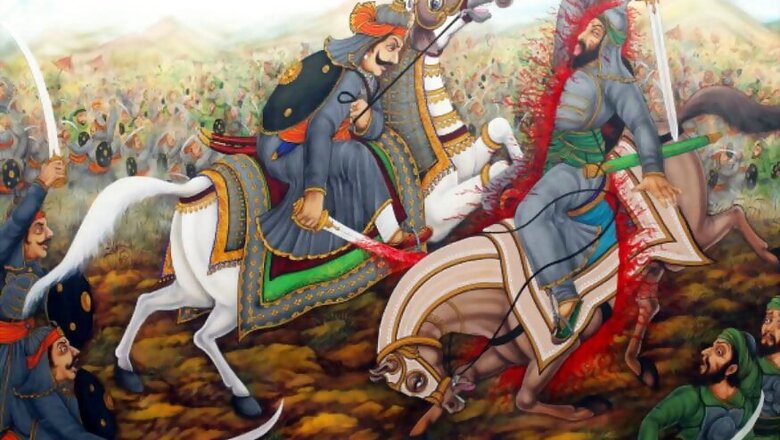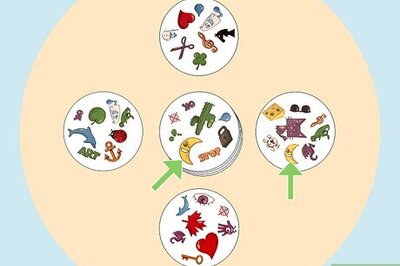
views
A reality check for the state that seeks to reinvent the past while its present is pock-marked by abysmal socio-economic indicators What is Rajasthan’s big dream, the vision of the state sold to its 7-crore strong electorate every five years?
What is Rajasthan’s big dream, the vision of the state sold to its 7-crore strong electorate every five years?
On the fringes of the BIMARU category of sick states, Rajasthan’s march towards fixing its dismal indicators in areas of healthcare, education, infrastructure, agricultural growth, drinking water, controlling crimes can wait.
The leaders of the state, instead, have a different vision for the state’s future, one obsessed with the past.
At least three ministers in the Vasundhara Raje-led BJP government — Education Minister Vasudev Devnani, Health Minister Kali Charan Saraf and Urban Development and Housing Minister Rajpal Singh Shekhawat — have backed a proposal to rewrite history on the outcome of the battle, which took place four and a half centuries ago.
While the ministers have been quick to join the Pratap-defeated-Akbar chorus, the Raje government made an unequivocal statement with silence in another row over history last month.
On January 27, Bollywood filmmaker Sanjay Leela Bhansali saw perhaps what Rajasthan tourism’s brand new tagline, ‘Jaaney Kya Dikh Jaaye! (Who knows what you might get to see)’ can mean in a rudely alternate way.
The protestors had assumed on the basis of a newspaper report that the film could possibly have romantic sequences between Padmavati, the fabled queen of Chittorgarh, and its attacker Allauddin Khilji.
Following the assault, Home Minister Gulab Chand Kataria said the government would act against the protestors only if someone came forward to file a complaint.
While the action was limited to six protestors being detained and let off, nuanced takes on the legend of Padmavati continue to fill social media timelines.
However, Chief Minister Vasundhara Raje — known for her powerful social media presence and for her tough stance against fringe groups vandalising art — chose to remain silent.
Incidentally, the Rajasthan education minister recently gave cow the distinction of being the only animal, which also exhales oxygen besides inhaling it, and backed his claim citing ‘German research’.
Not just that, the ASER 2016 report by Pratham, used by the annual Economic Survey, shows Rajasthan having the second highest percentage of girls aged between 11 and 14 years who are not in school. At 9.7 percent, this number puts Rajasthan next only to Uttar Pradesh.
This, when education is among the top stated priorities of Chief Minister Vasundhara Raje.
Raje recently signed a MoU with Dubai-based multinational education provider GEMS group to run 50 government schools, and the state is set to host an international education festival in April.
However, even as Rajasthan looks towards the future with such experiments, its leaders are not done ‘fixing’ history yet.
Official data points to the state’s dismal record when it comes to protecting the rights of women, children and Dalits — areas one wishes the state’s lawmakers would rather focus on.
The NCRB data on crimes against women puts a question mark on safety for women in Rajasthan’s major cities like Jaipur and Jodhpur.
Rajasthan has a far from ideal record when it comes to protecting the rights of Dalits and tribals.
According to the NCRB’s Crime in India report of 2015, Rajasthan contributed to over 15 percent of all cases of atrocities against SCs and STs. At 6,998 reported cases, the state’s figures are second worst — next only to Uttar Pradesh — in the country.
The Dangawas Dalit massacre — now being probed by the CBI — and the rape and murder of a Dalit student from Barmer are two cases that made national headlines, but other atrocities, such as caste Hindus not allowing Dalit grooms to ride horseback for their wedding, are all too frequent.
The number of student suicides continues to grow in Kota where over 1 lakh students from across the country take coaching every year for medical and engineering entrance exams.
While 17 students ended their lives in the coaching hub last year, two students have committed suicide this year.
The state’s financial health remains an area of concern. The recent six monthly review in (Fiscal Responsibility and Budget Management) FRBM report released by the state’s finance department shows the fiscal deficit is lingering at 5.6 percent against the required 3 percent.
With a shortfall in revenue earned by mining and transport the government is unlikely to be able to maintain fiscal deficit targets.
Departments in the state government have failed to not just spend the funds sanctioned in the state budget but also about 52 percent of the money from the provisioned amount for schemes sponsored by the Centre, including the flagship Swachh Bharat Mission remains largely unspent.
From the state budget as well in the past nine months, the government has spent only about 55 percent of the sanctioned plan budget.
According to a recent Union drinking water and sanitation ministry report tables in the parliament, Rajasthan has the highest number of habitations where groundwater contains fluoride.
Rajasthan has 6,589 habitations affected by fluoride with over 45 lakh people living there, out of the 13,334 fluoride affected habitations in the country.
Rajasthan’s daughters, data show, fare worse than their mothers. At 883, the state’s child sex ratio according to the 2011 Census (number of girls aged 0-6 years per thousand boys) actually dropped 26 points compared to 909 in 2001.
That makes it the fourth worst in the country. It stands fifth worst when it comes to the Infant Mortality Ratio — at 46/1000 live births, way below the target of 42 under the Millennium Development Goals.
The poor state of maternal and child health in Rajasthan can be ascertained from the fact that most posts of gynaecologists and paediatricians at Community Health Centres lie vacant.
According to NRHM’s state profile, only 14 posts of obstetricians and gynaecologists at CHCs are filled against a requirement of 382. Similarly, of the 382 paediatricians required at CHCs, only 11 are appointed. Besides, the state requires a total of 1,528 specialists at its CHCs. Only 148 of these are filled.




















Comments
0 comment